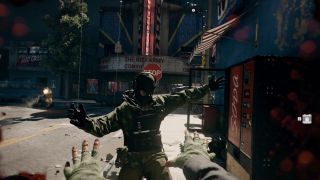Using enemies as shields fundamentally changes Call of Duty, while harking back to its crueller past
It's a cold new mechanic in Black Ops - Cold War.

I grab the stunned Spetsnaz soldier by his left shoulder and spin him round; on his right shoulder, I balance an assault rifle. Like a psychopathic puppeteer I walk him back and forth as I open fire, a witness to the murder of his colleagues. Eventually, though, he fills up with friendly bullets, growing heavier as the life leaves his body. I sink a long knife into his chest, and step over the slumped form.
It’s awful, I know. But undeniably useful. The body shield, as Cold War refers to it, is a tool that transforms gunfights, and Call of Duty with it.
COD has always been a cover shooter. Though it may not have a dedicated key to pull you close to nearby walls, like Gears of War or Rainbow Six Vegas, COD single-player has long leaned on a regenerating health system. First popularised by Halo, it’s a mechanic that forces you to fall back when hit, finding a quiet spot to pause and reconsider your approach. It’s also rightly criticised for slowing the pace of shooters, at worst turning them into fairground shooting galleries.
Only in 2016, with id Software’s Doom reboot, did the FPS genre really regain its sense of momentum. Doom’s glory kills encouraged you to push forward, seizing cacodemons to replenish your health. And, while the Slayer pulled a great green eye from its socket, you had a moment to plan your next act of aggression.

Cold War takes a little of that, without compromising COD’s principles. The body shield effectively functions as DIY cover—if there’s nothing to protect you between one point and another, you can grab a man and hide behind them. It’s a flexible move, too: depending on the evolving situation, you can either drag that human shield back into a less exposed position, or tuck a grenade into their vest and shove them towards their peers—pushing forward, Doom style.
In other words, Call of Duty has caught up with the genre it once revolutionised, making melee a primary part of its flow. Yet body shields also feel like a backwards step in terms of tone.
Raven Software’s Cold War campaign is, up to the point I’ve played at least, less nasty than Treyarch’s early Black Ops games. There’s little of Treyarch’s taste for horror, or relish for putting its protagonists through trauma. There are no tone-deaf shootouts in nightclubs set to Skrillex. But sliding a blade between the ribs of a helpless combatant feels like a brutal hangover from those days.
The biggest gaming news, reviews and hardware deals
Keep up to date with the most important stories and the best deals, as picked by the PC Gamer team.
Explicit and gory takedowns are hardly rare in shooters, of course - you’ll find very similar animations in Far Cry, and far more extreme ones in Doom Eternal. But where Doom’s geysers of blood contribute to a sense of cartoon violence, Cold War is at pains to root its action in the real world, forefronting its missions with archived news footage, then authentically recreating real-world battlefields and dictatorships. In that context, looking into the bewildered eyes of a man you’ve just strapped to an explosive - well, it hits different.
- Black Ops Cold War floppy disk code: How to get it
- Black Ops Cold War Red Circus suspects: Who to choose
- Black Ops Cold War dark ops challenges: Complete them all
- Black Ops Cold War prestige: How it works
- Best MP5 class loadout Cold War: Top setups
Most Popular

